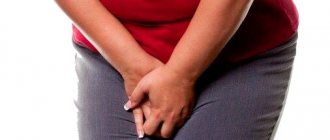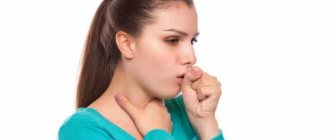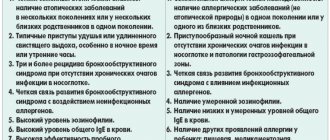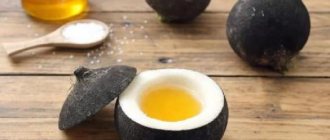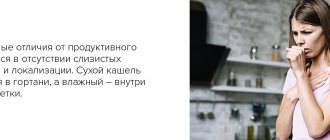Conventionally, all inhalations can be divided into two groups:
- Natural - when a person inhales clean mountain or sea air. This type of inhalation can be classified as therapeutic and prophylactic methods of therapy. This group has a mild therapeutic effect on the mucous membranes and is most effective for chronic diseases of the respiratory system, and also helps strengthen the immune system.
- Artificial. This is the inhalation administration of drugs into the upper respiratory tract using inhalers (nebulizers).
A nebulizer is a special portable device for inhalation. The word itself is of Latin origin: “nebula” translated from this ancient language means cloud or fog. These devices transform liquid medicinal substances using compressed air into aerosols or cold vapor (fog). It is then sprayed into the upper and lower respiratory system.
Inhalations can be recommended for almost all types of cough, but it is necessary to take into account which drug will be selected by the doctor. It may be different for each specific disease. [1]
Contraindications to inhalation are:
- Increased body temperature, more than 37.5 degrees.
- Cough accompanied by purulent sputum.
- Nosebleeds.
- Allergic reactions or intolerance to the components included in the solution.
- Arrhythmia.
- Severe diseases of the cardiovascular and respiratory systems.
Benefits of inhalation:
- A gentle and safe method of treatment.
- Significant reduction in the period of illness.
- Facilitating the process of sputum secretion.
- Reducing the risk of pathological processes at all stages of the disease.
- Reducing the severity of cough.
- Possibility of using natural herbal ingredients.
How are nebulizers different?
There are several types of nebulizers:
- Compressor
- Ultrasonic
- Membrane
Each has its own pros and cons. An important task of the nebulizer is to deliver the drug to the site of inflammation in the upper and lower respiratory tract. Ultrasonics can destroy medicinal active substances, and the effectiveness of treatment decreases. For home use, it is better to choose compressor or membrane ones. The former are more expensive and weigh more, but they do not require additional parts and are easy to clean. The latter are convenient to take on a trip, they are silent, but you need to buy consumables for them.
For children under 5 years of age, inhalations are performed while sitting using a special mask, which should fit tightly to the nose and mouth. Starting from 5 years old, children, as well as adults, breathe through a mouthpiece, which is included with the mask. You should inhale air through your mouth through the mouthpiece and exhale through your nose. After inhalation, rinse the mask, mouthpiece, and tubes with running water and soap, and dry thoroughly.
What inhalations can be done when coughing with a nebulizer?
Prospan drops are a natural remedy created on the basis of a unique formula. It is based on the healing properties of dry ivy leaf extract. Thanks to the use of plant components in the development of Prospan drops, and the absence of dyes and preservatives in their composition, they can be recommended not only for adults, but also for children from one year of age.
The undoubted advantage of Prospan drops is their complex effect on the respiratory system. Prospan has expectorant, mucolytic and bronchospasmolytic effects, reduces the viscosity of sputum and promotes its discharge.
Convenient when using drops is that all standard devices and devices for spraying without heating (nebulizers) are suitable here.
It is important to remember that the product contains ethyl alcohol. And in order to eliminate and minimize irritating side effects due to alcohol vapors, when inhaling with Prospan drops, they must be diluted with drinking water at room temperature in a ratio of 1:2.
Indications and contraindications
Typically, inhalations are prescribed for obstructive bronchitis, bronchial asthma, chronic obstructive pulmonary disease, and croup syndrome.
“The nebulizer is used only to deliver a medicinal substance to the mucous membrane of the respiratory tract,” says Anastasia Shledovitz, a pediatrician at the Fantasy children’s clinic, “so there are not many main indications for its use: bronchodilators for bronchial obstruction, inhaled hormones for croup syndrome and combination drugs for bronchial obstruction. asthma. Self-prescribing these drugs can be harmful, especially for young children.”
If you have a runny nose, sinusitis, sore throat, adenoids, or redness of the throat, inhalation is not recommended.
“Often in children during the adenoid period, cough and runny nose can drag on and go beyond the normal course of ARVI, that is, last more than 10 days,” says Oleg Abramov, an otolaryngologist and head of the center for operative surgery at GMS Hospital. — Such a cough should be treated with proper drug therapy aimed at reducing snot. Inhalations with saline or hormonal agents will not have any effect in terms of cough relief.”
Inhalations are most often prescribed for a sudden cough. The course of treatment usually ranges from 1 to several days. For “residual cough” after ARVI, which occurs after sleep and when leaving a warm room into a cold one and vice versa, treatment is usually not required.
“If a child or adult has been coughing for more than three weeks due to mucus draining down the back wall of the throat,” adds Oleg Abramov, “this requires consultation with an ENT doctor to conduct an endoscopic examination and identify the cause that may lead to this.”
If there is no pathology of the nasopharynx, but a persistent cough persists, it is necessary to visit a gastroenterologist, pediatrician or therapist, in some cases an infectious disease specialist.
How to properly carry out inhalation for children with a nebulizer?
- Before starting inhalation for your child, be sure to read the instructions for use of your specific device; there may be important nuances there.
- Remember that only a doctor can prescribe a competent treatment regimen, specific medicine and dosage.
- For inhalation, use only medications intended for this purpose, do not use boiled or distilled water - this will not only not be effective, but can also become dangerous and lead to bronchospasm. As for the use of mineral water without gas for inhalation, it can be used, but only as prescribed by a doctor, for example, when a child has a small amount of viscous sputum in the respiratory tract (cough with difficult-to-clear sputum). At the same time, the use of mineral water can cause irritation of the back wall of the pharynx, as well as provoke the bronchospasm already mentioned above. Also, do not use essential oils, infusions or herbal decoctions.
- A common question is whether it is possible to perform inhalations when a child has a fever. Depends on the temperature, but more likely no than yes. Doctors do not recommend inhalation for a child at a temperature above 37.5 degrees.
- Do not inhale immediately after meals or after active games or any other physical activity.
- Medicine that is stored in the refrigerator should be taken out and allowed to warm up slightly before use.
- If there are any elements on the child’s clothes that prevent him from breathing freely, remove them. Breathing should be free.
- After inhalation is completed, clean the device, all parts and dry them.
Questions about what inhalations to give to a child, inhalation recipes, how many minutes to do inhalations, how many days or how many times a day - all this is a treatment plan that the pediatrician will prescribe. Only a specialist, after examining the child and deciphering the tests, can give you answers to these questions. Self-medication can be ineffective and even dangerous.
Inhalations for coughing in children - features.
It is important to understand what kind of cough a child has - wet or dry; this will determine which medicine to choose for inhalation. When fighting a cough, inhalation is carried out as follows: inhale through the mouth, exhale through the nose.
Inhalations for a dry cough in a child are primarily aimed at moisturizing the mucous membranes and making the sputum more liquid. For this, doctors prescribe mucolytics, bronchodilators and/or anti-inflammatory drugs. At the initial stage of the disease, inhalation with saline solution may be sufficient (to the question of whether it is possible to inhale children with saline solution - the answer is “yes”, but only as prescribed).
For wet coughs, inhalations have a different purpose: to have an expectorant, disinfectant and antiseptic effect. This way, phlegm will be cleared from the lungs faster.
Inhalations for a runny nose in children - features.
For a runny nose or diseases of the nasal cavity, inhalations are carried out as follows: inhalation and exhalation are carried out strictly through the nose. For treatment, drugs such as sinupret, chlorophyllipt, miramistin, rotokan, rinofluimucil and others can be used (the specific drug and dosage are prescribed by the doctor, depending on the severity of the disease; the names of the drugs are given as an example and do not constitute a recommendation for treatment).
In what cases should inhalation not be performed with a runny nose:
- the child’s ears hurt, there is a suspicion of otitis media;
- mucus from the nose has a greenish or yellowish tint, this may indicate the development of a bacterial infection, and in this case, inhalation can cause complications;
- the child is predisposed to nosebleeds or pulmonary bleeding.
What solutions can be added to the nebulizer?
Only those that have instructions in the instructions for use of the drug: budesonide, impratropium bromide, ventolin, fluimucil - an antibiotic. Sputum thinners are not recommended for children under 12 years of age due to the possible worsening of the disease. It is not recommended to add mineral water, oils, various syrups and cough solutions, herbal tinctures, baking soda due to the high risk of side effects and prolongation of the cough period.
You can read the continuation of the article by following the link to FORMA - SBER PHARMACY blog.
Why does a dry cough appear?
First, it’s worth defining the very concept of a dry cough. Its main differences from the productive one are the absence of mucous secretions and localization. A dry cough forms in the larynx, and a wet cough forms inside the chest.
Under the influence of an inflammatory process, allergy or virus, the back wall of the larynx becomes irritated. A signal is sent to the brain that triggers the cough reflex to clear the airways. As a result, irritation of the mucous membrane of the larynx intensifies, which leads to the formation of another wave of coughing. It turns out to be a vicious circle.
When a dry cough appears, it is important to identify its cause in order to select adequate treatment. The symptom may occur when the larynx becomes inflamed or when the virus enters the lower part of the respiratory system. Sometimes in this way the body reacts to external irritants, internal pathologies, and allergens. Cough medications and treatment methods should be selected by a doctor after diagnostic procedures.
Indications for the procedure
Inhalations help with the following diseases with dry cough:
- bronchial asthma;
- laryngitis;
- acute and chronic diseases of the larynx;
- bronchitis;
- pneumonia;
- viral infections of the respiratory tract;
- disorders that arise from constant exposure to an unfavorable environment on the respiratory system with the subsequent development of a dry cough;
- tracheitis;
- angina.
Inhalations can also be performed as a prevention of respiratory pathologies or to consolidate the results of drug treatment.
What drugs are inhaled?
To combat dry cough, several groups of inhalation solutions are used:
- Salt;
- Saline solution;
- Compositions with bronchodilators;
- Expectorants;
- Antiseptic drugs and antibiotics.
Saline and alkaline solutions are considered the safest but most effective means. The substances they contain help moisturize the mucous membrane, soften the cough, and make the mucus more liquid so that it comes out more easily during a cough. For this purpose, soda solutions are mainly used.
Inhalations with salt solutions are carried out no more than 5 times a day. The duration of each procedure is 5-10 minutes; about 4 ml of solution is poured into the nebulizer. Inhalation of such substances is not contraindicated for children of any age and pregnant women.
Saline solution of sodium chloride (table salt solution) is sold by pharmacies in ready-made form. For inhalation, this product is used in pure form or used for mixing with medications. Saline solution has an antiseptic effect, reduces the degree of tissue swelling, and fights microbes. For inhalation you will need 2-4 ml of solution.
Bronchodilators are prescribed to block the inflammatory process, relieve swelling, expand the lumen of the bronchi, and accelerate the release of sputum. Such drugs include Nebutamol, Ventolin, Berotek, Berodual.
Expectorants are necessary for difficult mucus removal and unproductive cough. They are characterized by an anti-inflammatory effect, liquefying the mucous substrate, facilitating its release. Drugs of this type are Mucolvan, Ambrobene, Ambroxol, ACC, Lazolvan. They are used exclusively as prescribed by a doctor, who determines the dosage and frequency of inhalation. To prepare the composition for the nebulizer, you will need saline solution.
For coughs caused by bacteria, inhalations with Dioxycin, Gentamicin, Furacilin, Miramistin and other antibiotics are performed. Self-medication is unacceptable here; you must strictly follow medical recommendations.
When can and cannot use a nebulizer?
Nebulizer inhalations are performed for almost any ENT disease:
- bronchitis in acute, chronic, obstructive forms;
- pneumonia;
- tonsillitis;
- laryngitis;
- tracheitis;
- viral infections of the respiratory system;
- infectious diseases.
There are few contraindications for this procedure. These include a tendency to nosebleeds, respiratory or heart failure, and hypertension. Inhalations should not be performed in case of hemoptysis, individual intolerance to drugs, during or after myocardial infarction, or cerebral stroke.
Essential oils
Useful for the prevention of ARVI and influenza. Essential oils can only be poured into steam inhalers - for the prevention and treatment of the upper respiratory tract.
When oils enter the lower respiratory tract, they clog the bronchi, so they are prohibited from being used in nebulizers.
Saline solution
This combination of water and 0.9% sodium chlorine is physiological - the same concentration of sodium chlorine is found in blood plasma. Therefore, saline solution can be poured into the inhaler even for a child.
During inhalation, saline solution relieves irritation and swelling of the mucous membrane and promotes the removal of sputum. It can be made at home from table salt and distilled water.
Borjomi or Essentuki mineral water is considered an analogue of saline solution, but manufacturers do not recommend using them - the composition may contain suspensions that are not physiological.
Common questions about inhalation
Is it possible to give inhalations to children? Yes, you can. Moreover, this method is used for children almost more often than for adults (with the exception of some diseases that occur in adults that require constant use of inhalers, for example asthma). But when using inhalers, you should be careful: take into account the type of inhaler and your doctor's recommendations.
What inhalations can be given to children? Depends on what kind of illness the child is suffering from. Diseases, which include infections of the upper, middle and lower respiratory tract, require the use of drugs that relieve spasm of the respiratory tract, swelling and inflammation, and have an expectorant effect, which only a doctor has the right to prescribe.
Are all inhalations the same? No, not all, and the differences are not limited to the active ingredient. There is such a thing as dispersion - how small particles are suspended in the air that the patient inhales. The depth of penetration of the substance depends on this indicator: some will settle in the nose, some will reach almost the lungs. For specific diseases, recommendations should be given by a doctor, but you should not experiment on your own.
Price policy
Domestic drugs tend to be cheaper. The action is identical. But patients note the presence of side effects, so many still choose expensive drugs from imported manufacturers.
| A drug | Minimum price in rubles |
| Mukolwan | 149 |
| Ambrobene | 123 |
| Ambroxol | 288 |
| Lazolvan | 161 |
| Pulmozyme | 1480 |
| Fluimucil | 119 |
| Ventolin Nebula | 276 |
| Salbutamol | 50 |
| Astalin | 138 |
| Salgim | 1284 |
| Berotek | 98 |
| Berodual | 240 |
| Atrovent | 230 |
| Pulmicort | 398 |
| Cromohexal | 163 |
| Budenit | 707 |
| Tafen Nazal | 318 |
The issue of replacing one drug with another should be discussed with a specialist. The shelf life of medicines is 2-3 years from the date of manufacture, the prepared solution is from 30 minutes to 8 hours.
You need to breathe through a nebulizer if syrups, tablets, and mixtures do not give the desired result.
